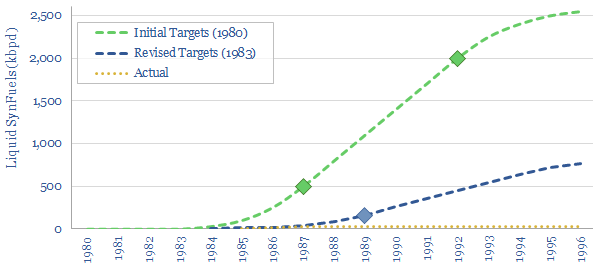Does policy de-risk new technology? This 10-page note is a case study. The Synthetic Fuels Corporation was created by the US Government in 1980. It was promised $88bn. But it missed its target to unleash 2Mbpd of next-generation fuels by 1992. There were four challenges. Are they worth remembering in new energies today?
The Synthetic Fuels Corporation was created by the US Government in 1980. To great fanfare. Its goal was unleashing synfuels. At $325bn in today’s money, its budget was actually quite similar to the energy-climate portion of 2022’s Inflation Reduction Act.
We explore other similarities between energy policies in the 1980s, the creation of the SFC, and emerging policies in the energy transition (pages 2-4). Our conclusion is that the similarities are surprisingly striking.
The main production pathway that was envisaged in the creation of synfuels started with coal, produced hydrogen as an intermediate, and then converted syngas into liquid fuels. The process is described in more detail on page 5.
Costs are a challenge. We have modelled the energy costs of synfuels, in today’s money, using models of coal gasification and gas-to-liquids. Ultimate costs of synfuels — in $/bbl and c/kWh-th — are derived on page 6.
Efficiency is a challenge. We modelled the thermodynamics and energy penalties of producing synfuels, in a helpful waterfall chart schematic on page 11. You cannot get around the second law of thermodynamics.
Other technical challenges are discussed on page 8. Some projects backed by the SFC simply did not work. Others were very small scale (around 5kbpd).
Politics could be described as the biggest barrier. Policies have an annoying habit of changing. The downfall of the US’s political push towards synfuels, which played out throughout the 1980s, is summarized on page 9.
Does policy de-risk new technology? We draw out conclusions for the energy transition on page 10. We all clearly want to avoid repeating mistakes of the 1980s. So our goal is to offer constructive suggestions for decision-makers, investors and project developers.
